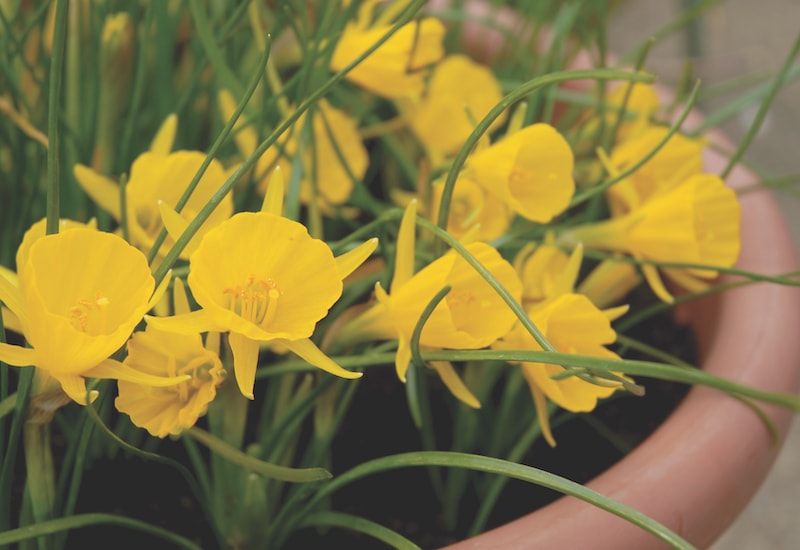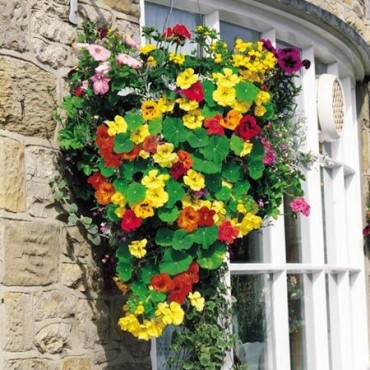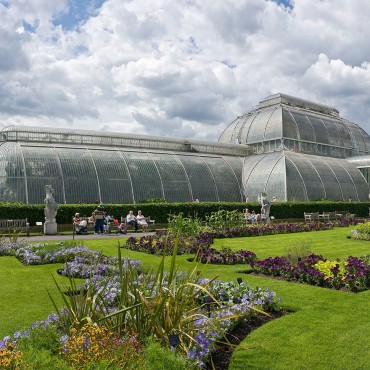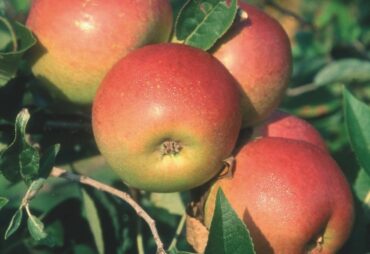When it comes to bringing a burst of colour to your garden, especially in early spring, planting bulbs, corms, and tubers is a real game-changer. Whether you tuck them into containers, load them into borders, or let them naturalise in your lawn, they’re sure to put on a spectacular show.
Here are practical tips on when, where and how deep to plant your bulbs, provided by our experienced horticultural team. Browse our full range of flower bulbs and tubers for more inspiration.
What are bulbs, corms, tubers and rhizomes?
Bulbs, tubers, corms and rhizomes are all types of underground root where a plant’s energy is stored. While these are sometimes grouped together and referred to as ‘bulbs’, they’re horticulturally different, especially when it comes to propagation. Here’s a quick definition of each:
- Bulb: A central shoot surrounded by tightly-wrapped layers, like an onion. Daffodils and tulips are some of the most common flowers that grow from bulbs.
- Corm: A solid underground storage unit with one or two buds on the top and roots underneath. Flowers that grow from corms include crocuses and gladioli.
- Tuber: A fleshy, swollen stem or root with nodes (eyes) from which new roots and shoots grow (like a potato). You can remove sections of a tuber, provided it has buds, to create more plants. Good examples include begonias and dahlias.
- Rhizome: A horizontal underground stem that produces roots from the bottom and sends up shoots from nodes along the top. Irises and cannas grow from rhizomes.
When to plant flower bulbs, corms and tubers

These pretty irises bloom through February and March
Image: Iris ‘Eyecatcher’ from Suttons (© Visions BV Netherlands)
The two main types of flower bulbs are spring-flowering bulbs and summer-flowering bulbs. A smaller group of autumn-flowering bulbs are also available.
- Spring-flowering bulbs should be planted in autumn, although save tulips until as late as possible, in November.
- Summer-flowering bulbs: hardy varieties can be planted in September and October while tender varieties (like gladioli) should be planted in late-spring.
- Autumn-flowering bulbs should be planted by the end of summer.
The earliest spring-flowering bulbs begin in January and the latest bulbs keep flowering right up until the end of the year. If you choose varieties that succeed one another, it’s possible to enjoy an almost continuous carpet of colour. And pollinators will thank you for providing much-needed nectar at crucial times of the year, especially very early and very late when little else is available.
Should you wish, you can artificially force some bulbs to flower outside of their usual season, by growing them indoors. Amaryllis and hyacinths are popular choices. Read our guide on how to force indoor bulbs for tips.
Popular bulbs for each season
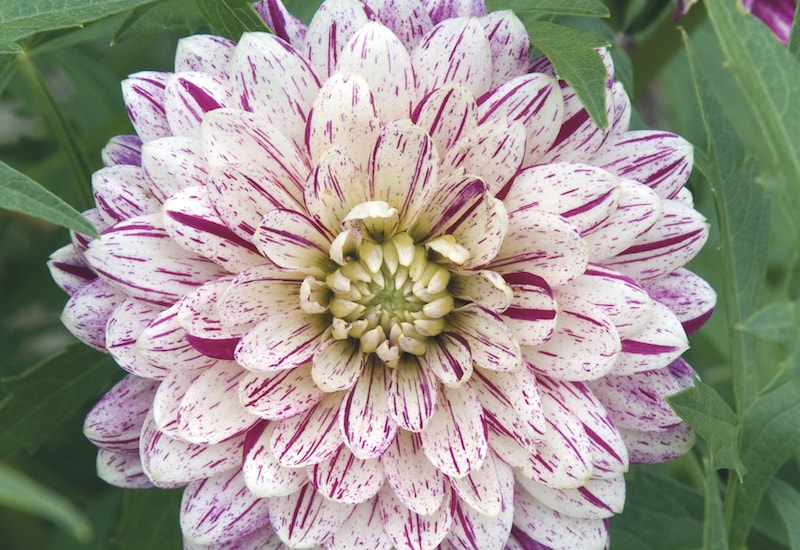
These beautiful speckled flowers brighten late summer borders
Image: Dahlia ‘Smokey’ from Suttons (© Visions BV Netherlands)
Here are some of the most popular bulbs, corms, tubers and rhizomes for each season:
- Early spring-flowering bulbs: snowdrops, crocuses, winter aconite, muscari, hyacinths, Iris reticulata and daffodils.
- Mid-spring bulbs: bluebells, daffodils, early tulips, fritillaria.
- Late-spring bulbs: late tulips, lilies, bearded iris and ornamental alliums.
- Mid-summer bulbs: gladioli, daylilies, begonias.
- Late-summer bulbs: calla lilies, canna lilies, crocosmia, agapanthus, dahlias, caladiums
- Autumn bulbs: nerines, autumn-flowering crocus, cyclamen hederifolium
Further growing guides and resources:
- Best expert advice on growing daffodils
- Best expert advice on growing tulips
- How to grow dahlias
- How to grow ranunculus
- How to grow ornamental alliums
- How to grow saffron crocus
- How to grow amaryllis
What to do when your bulbs arrive

These vibrantly coloured callas pop against their silver-spotted, heart-shaped leaves
Image: Calla Lily ‘Spectrum Mixed’ from Suttons
If you order your bulbs online, they’re usually dispatched at the correct time for planting. For the very best results, try to get them into the ground as soon as they arrive. But, if the weather throws a spanner in the works, you can store them temporarily for about two to three weeks. Pop them in a dry, dark, and cool spot, making sure it’s completely frost-free.
To store bulbs successfully, take them out of their original packaging and spread them out on trays, leaving enough space between each one for good airflow. Alternatively, a cardboard box works well – just use scrunched-up newspaper to keep them separated. A cool cupboard, garden shed, or even a garage can be ideal for short-term storage. Do keep an eye on them, though, as longer storage times can cause the bulbs to lose their vigour.
What’s the best soil for flower bulbs?
Every plant has its own quirks when it comes to growing conditions but, as a general rule, most bulbs thrive in well-drained soil. If they sit in soggy ground, they’re much more likely to rot, so good drainage is key.
If you garden on heavy clay, it’s a good idea to improve the soil by digging in plenty of bulky organic matter. Adding well-rotted manure and composted bark are good ways to help clay drain better.
Which way up do you plant a bulb?

These perennial tulips have excellent weather resistance
Image: Tulip ‘Everlasting Mixed’ from Suttons (© Visions BV Netherlands)
Generally speaking, you should plant bulbs with their pointed growing tip facing upwards. If you’re not entirely sure which end is up, don’t worry – you can plant them on their side, and they’ll usually find their way.
Some tubers, like begonias, are flatter and don’t have an obvious growing point. For these, simply position them just beneath the surface of the compost with the indented side facing upwards.
Planting depths for bulbs and tubers
The ideal planting depth for bulbs and tubers varies depending on their size and type. However, most bulbs should be planted at a depth of about three times their own height. There are a couple of exceptions: cyclamen and begonia tubers should be planted just at the soil surface, and it’s often best to start begonias off in pots indoors first.
Here’s a handy guide for common bulbs and tubers:
| Type | When to plant | Planting depth | Planting distance | Position |
| Allium bulbs | Autumn | 10cm – 15cm | 10cm | Full sun |
| Crocus bulbs | Autumn | 10cm | 7cm | Full sun, Semi-shade |
| Daffodil bulbs | Autumn | 10cm – 15cm | 10cm | Full sun, Semi-shade |
| Bluebell bulbs | Autumn | 10cm | 10cm | Dappled shade |
| Iris reticulata bulbs | Autumn | 10cm | 8cm | Full sun |
| Lily bulbs | Autumn | 10 – 20cm | 15cm | Full sun, Semi-shade |
| Narcissus bulbs | Autumn | 10cm – 15cm | 10cm | Full sun, Semi-shade |
| Ranunculus corms | Autumn | 8cm | 25cm | Full sun |
| Snowdrop bulbs | Autumn | 10cm | 10cm | Dappled shade |
| Tree lily bulbs | Autumn | 10cm – 15cm | 15cm | Full sun, Semi-shade |
| Tulip bulbs | Autumn | 15cm | 13cm | Full sun |
| Hyacinth bulbs | Autumn | 10cm | 8cm | Full sun, Semi-shade |
| Begonia tubers | Spring | 1cm | 30cm | Full sun, Semi-shade, Dappled shade |
| Dahlia tubers | Spring | 15cm | 45cm | Full sun |
| Gladiolus corms | Spring | 10cm | 15cm | Full sun |
| Winter aconite bulbs | Spring | 5cm | 5cm | Full sun, Semi-shade, Dappled shade |
| Cyclamen hederifolium | Late summer | 2.5cm | 15cm | Partial shade |
| Nerines | Late summer | Neck exposed | 10cm | Full sun |
Can you grow flower bulbs in containers?
Planting bulbs in pots is a brilliant way to enjoy a vibrant splash of colour exactly where you want it. Once they’ve finished flowering, you can simply move the containers out of sight while the bulbs die back and go dormant. Alternatively, extend the life of your container display using the lasagne planting technique. Layering bulbs with different flowering times in the same pot ensures that new blooms will keep emerging just as the previous set finishes.
To successfully grow flower bulbs in containers, use a good quality general-purpose compost and mix in a handful of fine grit to help with drainage. You can also opt for specially formulated bulb compost if you prefer.
Once the bulbs start to grow, water them regularly and continue throughout their flowering period. Once the foliage starts to fade, you can gradually cut back on watering as they head into their dormant phase.
How to plant bulbs in your lawn

Bulb planters with depth markings take the guesswork out of bulb planting
Image: Bulb Planter from Suttons
Naturalising bulbs in your lawn creates an impressive display. They look best when scattered informally in areas of grass that you can leave unmown until the bulb foliage has completely died back.
For a really natural, effortless look, gently scatter the bulbs across the planting area and simply bury each one where it lands. Use a sturdy trowel or a bulb planter to dig a hole to the recommended depth, drop the bulb in, then cover it with soil. Gently firm the earth around the bulbs to get rid of any air pockets. Try to avoid treading on the ground too much afterwards, as this could damage the delicate growing tips as the soil settles.
If you’re planting a large number of bulbs, it might be easier to lift an entire piece of turf with a spade, arrange the bulbs underneath, and then carefully replace the turf. Daffodils, crocuses, snowdrops and bluebells are most commonly chosen for this sort of planting. Read our guide on how to naturalise bulbs for more information, along with our best expert advice on growing crocus bulbs.
How to care for your flower bulbs
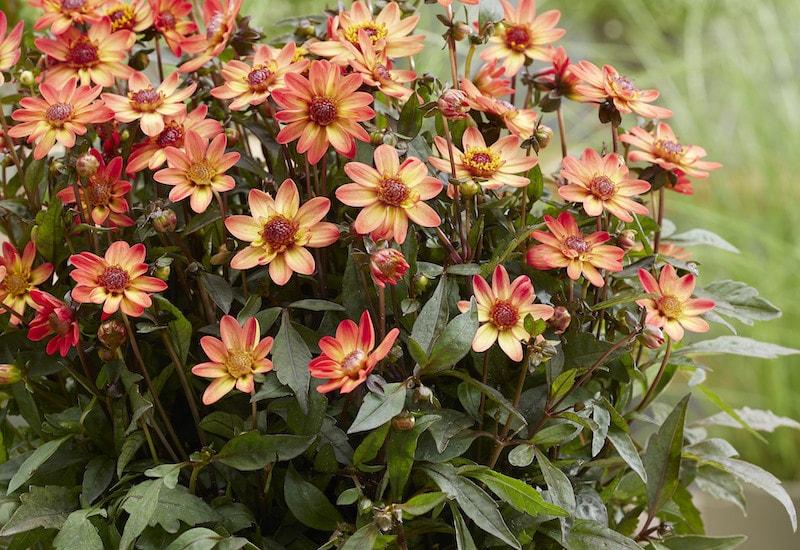
Dahlia ‘Star Wars’ grows to just 30cm tall making it ideal for containers
Image: Dahlia ‘Star Wars’ from Suttons (© Visions BV Netherlands)
Provided you plant them at the correct depth, most bulbs are very low maintenance and will look after themselves. Water containerised bulbs while they’re in active growth, gradually reducing the water as they die back and approach their dormant season. Here are a few care and maintenance tips to help you get the most from your bulbs:
- Always deadhead: Removing faded blooms from tuber and rhizome plants will encourage them to keep flowering. For plants grown from bulbs and corms, removing spent blooms won’t produce more flowers, but it will redirect energy back into the bulb for next year, rather than using it for seed formation.
- Feeding:Bulbs and corms grown in borders and grass don’t require feeding. Containerised bulbs can be fed with a high potassium liquid tomato feed as soon as the first shoots appear, continuing until the foliage begins to die back. Very vigorous summer-flowering tubers and rhizomes like cannas and dahlias like a high-potash feed twice a month through the flowering season.
- Allow foliage to die back naturally: Avoid cutting back any foliage before it has completely died back. The leaves are needed to replenish the bulb’s energy for next year’s blooms.
- Lift and divide true bulbs every three years: If your displays start to look disappointing, the bulbs may be overcrowded. Lift and divide clumps of spring bulbs like bluebells, snowdrops, daffodils and crocuses and split them into smaller clumps before replanting. The best time to do this is about 6 weeks after they have finished flowering.
- Leave hardy bulbs in the ground: Hardy bulbs can be left in the ground all year round to return year after year.
- Lift and store tender bulbs for winter: If you live in a colder part of the UK or have heavy soil, tender and half-hardy varieties like dahlias and cannas should be lifted for winter. For milder areas, you might get away with leaving them in situ, provided they’re insulated with a thick layer of mulch. If you’ve grown your tender bulbs in containers, simply move them indoors over winter.
We hope this guide helps you get started with planting your bulbs, corms, and tubers for a truly spectacular display. Check out some award-winning spring bulbs to plant in autumn for more inspiration. Happy gardening!
Last Updated on September 15, 2025 by Suttons Horticultural Team

